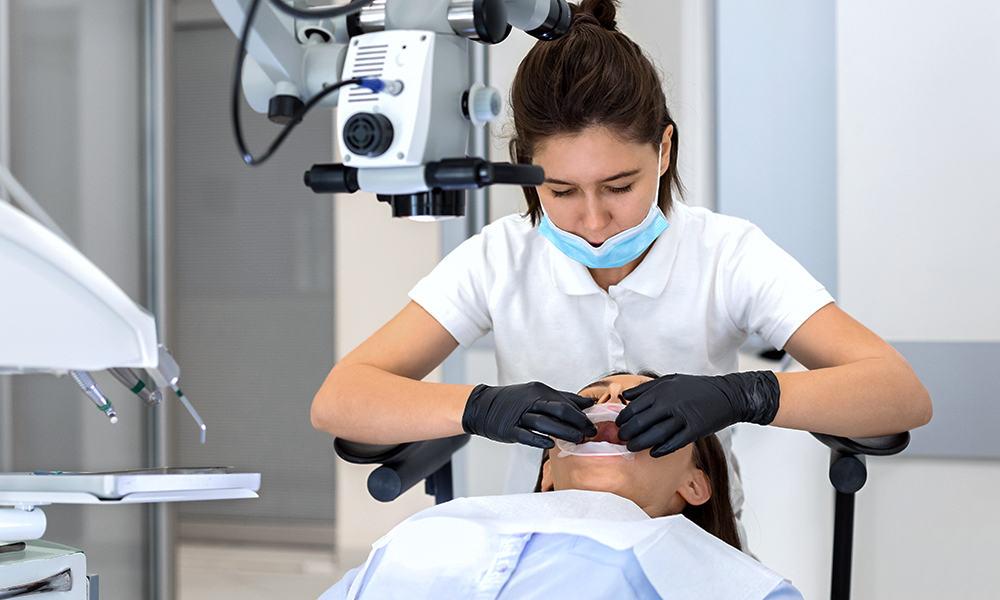Periodontics
Regenerative Procedures

If left untreated, periodontal disease is a very dangerous illness that progresses over time and can cause tooth loss. Bone and gum tissue begin to pull away from the teeth as a result of periodontal disease, which is brought on by a bacterial infection in the gum pockets. As the gum pockets develop, both the quantity and quality of bone and gum tissue are significantly reduced. Thankfully, early diagnosis and successful gum tissue regeneration treatments can stop the disease’s development and save the teeth.
To cure the gums, bone, and teeth, several regenerative dentistry techniques are available. The most common reconstructive procedures are listed below.
Bone Regeneration
The jawbone must be robust and strong enough to support dental implants and other restorative operations. The jawbone may have gotten too thin to adequately support an implant when periodontal disease has taken hold. One of the finest ways to encourage growth and thicken the jawbone is natural bone regeneration (also known as bone grafting).
The first source of bone grafting material is either a bone bank or another area of the patient’s body. In order to create a space in the jawbone where the grafting material would be snugly packed, the gums are gently pushed back. To facilitate faster healing, a membrane is employed to keep the form of the new bone, and tissue stimulating proteins and a platelet-rich growth factor may be used. In addition to being stuffed with padding, the surgical site will be sutured. The bone will ultimately gradually repair and strengthen to the point where it can sustain an implant.
Regeneration of Gum Tissue
Gum grafting is the most common technique for regenerating gum tissue. The smile may seem toothy, discolored, or unpleasant when gum tissue has been removed due to periodontal disease. A gum graft seeks to cover any exposed tooth roots, properly reshape the gum line, and improve the condition of the gums. A thin strip of tissue will first be cut from the roof of the mouth of the patient and positioned in the center of a split-thickness incision. After applying a protective barrier that encourages tissue regeneration, platelet-rich growth factor, and tissue-stimulating proteins, the surgical site will be covered, and sutured closed. Naturally regenerating soft tissue will provide a bright smile by covering the teeth’s gumline.
Surgery for Pocket Reduction
By reducing the depth of the gum pockets, pocket reduction surgery aims to make it far more difficult for germs to enter the gum tissue. To begin, the gum tissue is separated from the teeth, and local anesthetic is used to properly clean the subgingival region. To completely remove the tartar, dirt, and plaque from below the gum line, extensive scraping may be needed. After that, the surgical incision will be sutured up, and an antibiotic solution may be used to eradicate any lingering germs in the affected region. The natural healing of the gums is greatly accelerated and tissue loss is stopped with the help of pocket reduction surgery.
Root-planing and Scaling
Plaque and calculus (tartar) removal from the supragingival area is referred to as “scaling” (above the gum line). In scaling and root-planing, this procedure is often carried out as part of a regular professional cleaning and is done under local anesthesia. Scaling is often followed by root planing, which is done in the subgingival area (below the gum line). The tooth root is first cleaned of tartar and poisons before being smoothed down to encourage healthy gum tissue repair. The tooth root is planed to provide a smooth surface that inhibits the re – growth of microorganisms. Surgical treatments can be necessary if these methods don’t entirely remove the disease.
Ask your periodontist Dr. Elliott Weidman any questions you may have regarding periodontal disease or regenerative procedures.

Book Appointment
Do you need to see a dentist? We’re here to help. Book your next dental visit with ease.
FREE IMPLANT CONSULTATION
CATEGORIES
- Cracked tooth
- Avulsed tooth
- Broken, lost, or loose crown
- Gum abscess
- Broken denture
- Toothache
- Head injury such as a fall
- Loose implant
FOLLOW US

Book Appointment
Do you need to see a dentist? We’re here to help. Book your next dental visit with ease.

Book Appointment
Do you need to see a dentist? We’re here to help. Book your next dental visit with ease.
FREE IMPLANT CONSULTATION
Considering implants?
Schedule a 30-minute FREE, no-obligation office consultation with us.
Call (289) 815-5385 or complete an online appointment request.
CATEGORIES
- Cracked tooth
- Avulsed tooth
- Broken, lost, or loose crown
- Gum abscess
- Broken denture
- Toothache
- Head injury such as a fall
- Loose implant
FOLLOW US
Take a peek inside our dental office.
What Our Practice Looks

Mon - Thu: 8:30 AM - 5:00 PM
Alternating Fri: 10:00 AM - 3:00 PM
Follow Us
Contact Us

Mon - Thu: 8:30 AM - 5:00 PM
Alternating Fri: 10:00 AM - 3:00 PM
Follow Us
Contact Us
© All Rights Reserved aestheticimplantdentistry.ca
Privacy Policy | Terms of Use | Sitemap
A Dentistfind Website



